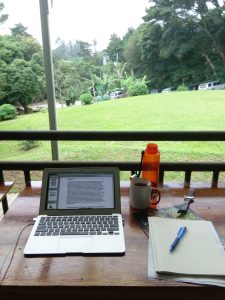A new part of the world seemed like a really great opportunity to try out new lessons in librarianship. So the opportunity to work at Monteverde Institute’s Library in the heart of the cloud forest in Costa Rica was an incredible opportunity.
Librarianship for Science Literacy

Adrienne Canino G’18 in Monteverde, Costa Rica
I came into librarianship, like many others, through another career path. I first studied watershed policy and community engagement at SUNY College of Environmental Science and Forestry. My undergraduate degree is also in Environmental Studies. I currently work in environmental education with a youth program in Syracuse. Perhaps because of this background, an internship at a research institute in one of the world’s biodiversity hot spots held a lot of appeal for me.
A Research Library in the Cloud Forest
Did you know that a cloud forest is a different climate than a rain forest? I first heard about this internship when I was debating applying to, and then debating matriculating in, Syracuse’s Masters of Library and Information Science program.
The intersection of science literacy and librarianship has fascinated me for several years. I heard about a project in digital libraries in a Costa Rican cloud forest. I thought: ‘wow, that’s a really great way to bring libraries and science together.’
As a busy start to the LIS program came and went for me, internship ideas also came and went. When I returned to the idea of the cloud forest, I contacted with iSchool alum and current academic librarian Laurie Kutner, intern supervisor for those who have participated in the past. I was lucky enough to be accepted, and supported by faculty, friends, and employers. Before long, I was on a plane to the tropics!
The Monteverde Institute is a non-profit that hosts academic programs from universities, research, and community initiatives to guide the sustainable growth of Monteverde and its booming eco-tourism business. For me, the plan was to work on the digital collections at the library, as well as new outreach opportunities and a digital exhibit. Since this was a learning experience for everyone involved, we were all excited at the possibilities.
Creating Digital Exhibits
The main project I’ve undertaken is creating a digital exhibit that will enhance and engage people with the Monteverde Institute Library’s digital collections.
This project started off by being called a digital exhibit. But once the team met in Monteverde for the first time, we decided that “digital exhibit” was hard to describe. So, in a reverse nick-name process, we called it ‘a multi-media online educational tool.’
The goal was to create a website that could provide an introduction to materials curated from the library’s digital collections, faculty knowledge, and outside authority. This resource would then be available to students, faculty, and the Monteverde community. It would serve as a sort of ‘welcome mat’ to engage with the Monteverde Institute Library, online or physically.
The process was a lot of fun. The focus was one of the installations that serves as a model demonstrating sustainable waste water treatment. We featured biogardens, which treat ‘gray water’ from the kitchen and bathroom sinks of the institute.
To make videos, inform the storyline of the exhibit, and have photos, I spent time interviewing Institute faculty. I also conducted some research and experimentation on potential softwares and different options for building and then launching the exhibit.
Leaving a Lasting Impact

Working outside at the Monteverde Institute.
For the construction, several challenges presented themselves: funds, knowledge, and longevity. Longevity was important because a digital exhibit needs a plan for display, maintenance, and retirement. The library does not have resources to spare to pay for hosting, software, or even simple server space. Although powerful, many digital exhibit software systems require some advanced technical skills. Even if I took the time to learn those skills, there would be a gap once I returned home.
WordPress became the best option. It also provided new outreach opportunities for the library through a blog and galleries hosting other library programs. Please check out the final product at mvilibrary.wordpress.com and let me know what you think!
The internship was the entire month of June, and in addition to my daily work, I lived in the cloud forest! I stayed in a homestay arrangement, which really increased my Spanish knowledge, and basically got a crash course in information access (or, more accurately in the global south, information poverty). Like all good internships, this has influenced my career path for the better.
